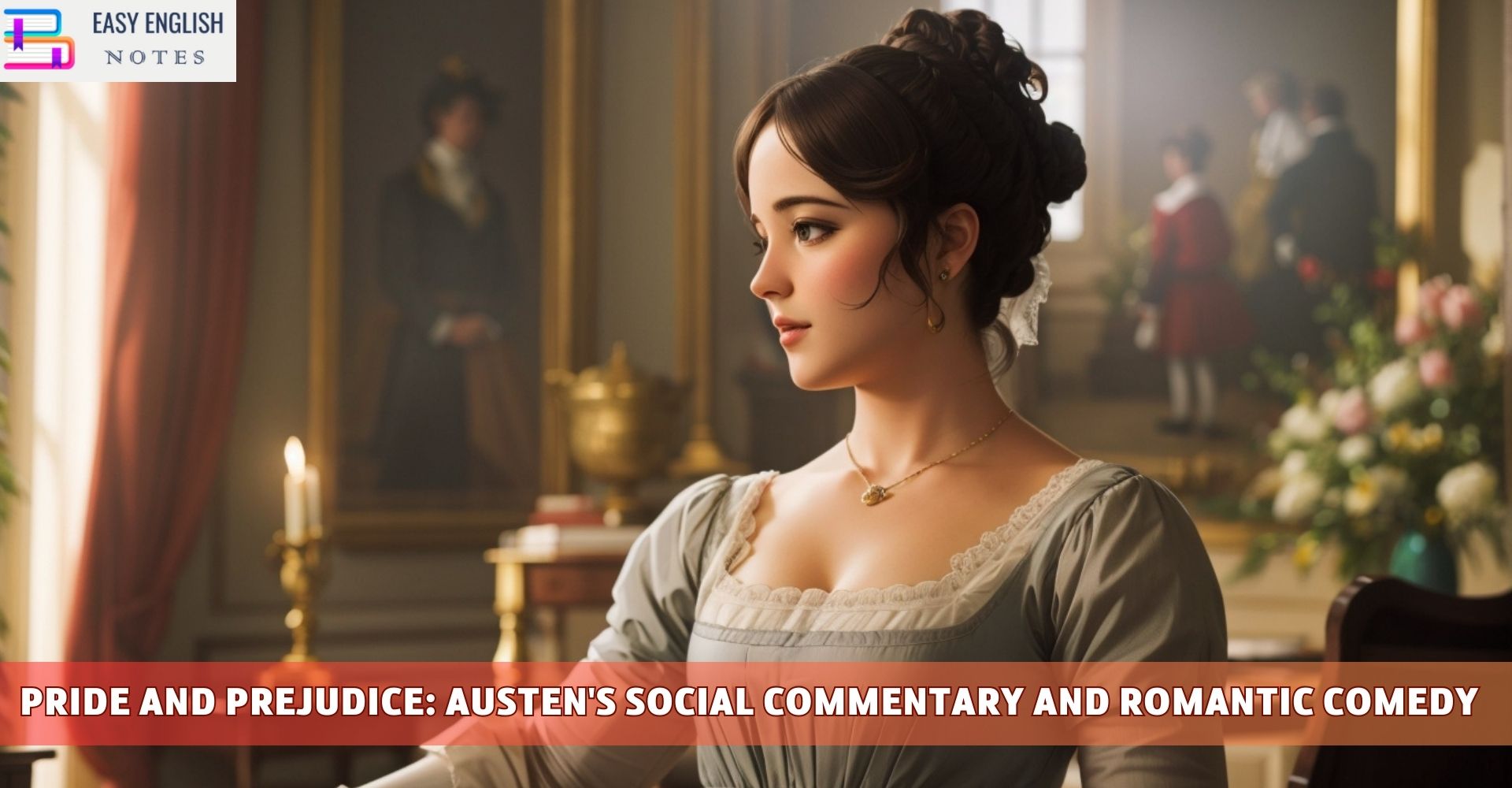Introduction:
“Pride and Prejudice,” a novel by Jane Austen, masterfully combines elements of social commentary with the charm of a romantic comedy. Written in the early 19th century, it offers a keen insight into the societal norms and class structures of Regency England, all while narrating a timeless love story.
Plot Overview:
The novel follows Elizabeth Bennet, the second of five daughters in a country gentleman’s family, in her encounters with the wealthy and aloof Mr. Darcy. Elizabeth’s wit, intelligence, and independence contrast sharply with the period’s expectations of women. The narrative unfolds their evolving relationship, marked by misunderstandings, personal growth, and social pressures.
Social Commentary:
Austen’s critique of the social structure of her time is a central theme. The novel highlights the limited options available to women, for whom marriage was often the only means to secure financial stability and social status. The character of Mrs. Bennet, obsessed with marrying off her daughters, exemplifies the societal pressures faced by women.
Class and Social Mobility:
Class distinctions and the challenges of social mobility are intricately depicted. Characters like Mr. Darcy and Lady Catherine de Bourgh represent the upper echelons of society, often appearing dismissive of those beneath them. In contrast, the Bennets, though respectable, lack substantial wealth, highlighting the nuanced social hierarchies of the time.
Character Development and Romantic Elements:
Elizabeth and Mr. Darcy’s characters undergo significant development. Initially, Elizabeth’s prejudice against Darcy and his pride in his social standing create conflicts. However, as they overcome these traits, their relationship evolves, embodying the novel’s exploration of misunderstanding and growth in love.
Themes:
- Pride and Prejudice: The title reflects the central themes. Characters must overcome personal pride and societal prejudices to understand each other truly.
- Marriage: The novel examines marriage as a complex social contract, offering commentary on the intersection of love, practicality, and social expectation.
- Individual vs. Society: Elizabeth’s character challenges societal norms, asserting individual desires and opinions in the face of social expectations.
Narrative Style and Wit:
Austen’s narrative style is noted for its clarity, realism, and wit. Her use of free indirect discourse allows readers to see the world from Elizabeth’s perspective, blending the protagonist’s internal monologues with the narrator’s voice.
Cultural and Historical Context:
“Pride and Prejudice” provides insight into the early 19th-century British gentry. Its portrayal of gender roles, class, and marriage reflects the cultural and historical context of Austen’s time.
Relevance and Legacy:
The novel remains relevant for its timeless exploration of love, family, and society. Austen’s ability to create complex, realistic characters and her sharp social commentary have cemented “Pride and Prejudice” as a classic in English literature.
Also Read :
- Compare Hamlet with Macbeth, Othello and other Tragedies
- “The Pardoner’s Tale” is the finest tale of Chaucer
- Prologue to Canterbury Tales – (Short Ques & Ans)
- Confessional Poetry – Definition & meaning
- Line By Line Explanation Of The Poem The Eve of St. Agnes
Character Dynamics and Relationships:
- Elizabeth Bennet and Mr. Darcy: The evolving relationship between Elizabeth and Darcy is central to the novel’s narrative. Their journey from initial aversion to mutual respect and love is a study in understanding and overcoming personal flaws.
- Jane Bennet and Mr. Bingley: Jane, Elizabeth’s elder sister, and her relationship with the amiable Mr. Bingley contrast with Elizabeth and Darcy’s. Their straightforward romance, though hindered by societal norms and misunderstandings, adds a layer of optimism and simplicity.
- Secondary Characters: Characters such as Mr. Collins, the sycophantic clergyman; Lydia Bennet, the reckless younger sister; and Wickham, the charming but unscrupulous officer, contribute to the novel’s exploration of various societal attitudes and behaviors.
Satire and Irony:
Austen uses satire and irony to critique societal norms. Mr. Collins’ obsequiousness towards Lady Catherine and his absurd proposal to Elizabeth highlight the absurdity of marriage and class conventions. Similarly, the irony in Elizabeth’s initial judgment of Darcy versus her eventual realization reflects the novel’s theme of misconceptions.
Feminism and the Role of Women:
Elizabeth’s character can be seen as a feminist icon for her era. She challenges the traditional notion of women being dependent on marriage for security and status. Her intelligence, wit, and moral integrity set her apart from typical portrayals of women in early 19th-century literature.
Literary Style and Technique:
Austen’s writing style is notable for its use of dialogue to reveal character and advance the plot. Her precise language and balanced structure contribute to the clarity and effectiveness of her social critique. The use of free indirect speech allows readers to engage intimately with Elizabeth’s perspective, blurring the line between the character’s thoughts and the narrative voice.
Influence on Modern Culture:
“Pride and Prejudice” has had a significant impact on modern culture. It has inspired numerous adaptations, including films, TV series, and literary retellings. The story continues to resonate with contemporary audiences, reflecting its universal themes of love, class, and societal expectations.
The Novel’s Enduring Appeal:
The lasting appeal of “Pride and Prejudice” lies in its insightful exploration of human character and relationships set against a backdrop of societal norms. Austen’s blend of romance, social commentary, and moral introspection ensures that the novel remains relevant and engaging.
Conclusion:
“Pride and Prejudice” is more than a romantic novel; it is a profound social commentary. Austen’s incisive observation of human behavior and societal norms, combined with her humorous and intelligent narrative, makes the novel an enduring study of character, love, and social standing. Its appeal lies not only in the romance between Elizabeth and Darcy but also in its exploration of the human condition within the context of its time.
PLEASE HELP ME TO REACH 1000 SUBSCRIBER ON MY COOKING YT CHANNEL (CLICK HERE)











